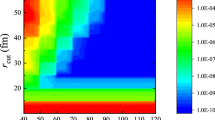Summary
A closed-form expression providing an upper bound (lower bound in modulus) for the energy per particle in balanced nuclear matter is obtained, starting from the hyperspherical-expansion approach to nuclear bound states, and considering nonlocal two-body nuclear potentials. This formula is compared with the analogous expression that obtains in the standard Fermi-gas treatment; numerical results for the potentials of Tabakin and of Hamman and Ho-Kim are reported and discussed. Some of the formulae given in this paper are also of value to recast results given in previous papers of this series in a more convenient form.
Riassunto
Si ricava un’espressione in forma chiusa che fornisce un limite superiore (limite inferiore in modulo) per l’energia per particella in materia nucleare bilanciata, partendo dal metodo dello sviluppo in onde ipersferiche e considerando potenziali a due corpi non locali. Questa formula viene messa a confronto con la formula analoga che si ottiene nel trattamento standard (gas di Fermi); e si riportano e discutono risultati numerici per i potenziali di Tabakin e di Hamman e Ho-Kim. Alcune delle formule date in questo lavoro sono anche utili per riformulare in forma più conveniente risultati ottenuti in precedenti lavori di questo ciclo.
Реэуме
Исходя иэ подхода к ядерным свяэанным состояниям с исполяэованием гиперсферического раэлозения и рассматривая нелокаляные двухчастичные ядерные потенциалы, получается в эамкнутои форме выразение, определяушее верхнуу границу (низнуу границу по модулу) для знергии свяэи на частицу в уравнове-щенном ядерном вешестве. Эта формула сравнивается с аналогичным выразением, которое получается при стандартном рассмотрении Ферми-гаэа. Приводятся и обсуздаутся численные реэулятаты для потенциалов Табакина и Хаммана и Хо-Кима. Некоторые иэ приведенных в зтои работе формул представляут переписанные в более удобнои форме реэулятаты, полученные в предыдуших работах зтои серии.
Similar content being viewed by others
References
A. M. Badalyan, F. Calogero andYu. A. Simonov:Nuovo Cimento,68 A, 572 (1970);F. Calogero andYu. A. Simonov:Nuovo Cimento,67 A, 641 (1970);F. Calogero, Yu. A. Simonov andE. L. Surkov:Nuovo Cimento,1 A, 739 (1971);F. Calogero, A. D’Andrea, E. Olivieri, O. Ragnisco, M. Scalia, Yu. A. Simonov andE. L. Surkov:Nuovo Cimento,14 A, 445 (1973). These paper are hereafter referred to as BCS, CS, CSS and CDORSSS.
F. Tabakin:Ann. of Phys.,30, 51 (1964). The parameter of this potential, that is missing in this paper, has been recovered from the paper byD. M. Clement andE. U. Baranger:Nucl. Phys.,108, 27 (1968) (in fact, this paper describes the Tabakin potential more explicitly than the original paper byTabakin; it should be specified that the parameters that we have used for the1 P 1-wave are those listed as1 P 1 (new)).
T. F. Hamman andQ. Ho-Kim:Nuovo Cimento,64 B, 356 (1969). The value of the parameterB 2 of3 D 1 given in this paper is misprinted; it should read 448.0 rather than 4.48 (private communication by Prof.Q. Ho-Kim). See also, by the same authors,Nuovo Cimento,64 B, 367 (1969);67 A, 300 (1970).
See, for instance,F. Calogero:Variable Phase Approach to Potential Scattering, Appendix I (New York, 1967).
The parametersα are given in ref. (3), together with parametersB, that are related to the parametersC of eq. (2.10) byC nJSTll′ =\(\mathchar'26\mkern-10mu\lambda \) B nJSTll′ , with\(\mathchar'26\mkern-10mu\lambda \)=ℏ2/m=41.47 MeV fm2. Only the more « realistic » potentials labelled I and III are considered below.
The parametersa, b, c, d, γ andβ are given in ref. (2), together with the parameterss JSTll′ andt JSTll′ , that have the values +1 or −1 and are related to the parametersC of eq. (2.10) byC 1JSTll′ =s JSTll′ andC 2JSTll′ =t JSTll′ .
See, for instance, Table 10 of the review paper byH. Bethe:Ann. Rev. Nucl. Sci.,21, 93 (1971).
Here GR 8.552 means eq. 8.552 ofI. S. Gradshteyn andI. M. Ryzhik:Tables of Integrals, Series and Products (New York, 1965). This notation is used throughout this Appendix.
Author information
Authors and Affiliations
Additional information
Research partially supported by the Consiglio Nazionale delle Ricerche (G.N. F.M.A.M.F.I.).
Supported by a University of Rome Fellowship, at present on leave for military service.
Rights and permissions
About this article
Cite this article
Calogero, F., Oliveri, E., Scalia, M. et al. The hyperspherical-expansion approach to nuclear bound states. Nuov Cim A 14, 477–500 (1973). https://doi.org/10.1007/BF02756271
Received:
Published:
Issue Date:
DOI: https://doi.org/10.1007/BF02756271




